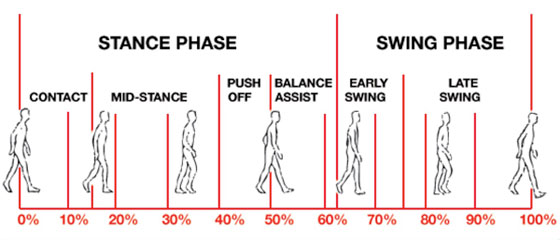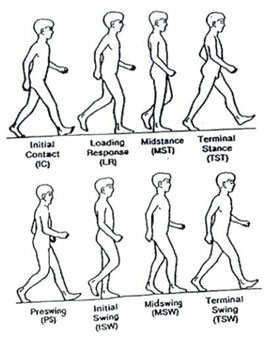Gait

The normal Human Gait involves the following stages:
Stance (Support) Phase:
Begins when the heel of the forward limb makes contact with the ground and ends when the toe of the same limb leaves the ground.
Heel Strike- Heel of forward/reference foot touches the ground.
Mid Stance - Foot is flat on the ground and the weight of the body is directly over the supporting limb.
Toe Off - Only the big toe of the forward / reference limb is in contact with the ground.
Swing (Unsupported) Phase:
Begins when the foot is no longer in contact with the ground. The limb is free to move.
Acceleration- The swinging limb catches up to and passes the Torso.
Deceleration- Forward movement of the limb is slowed down to position the foot for heel strike.
Double Support:
Both limbs are in contact with the ground simultaneously.
Gait Cycle:
The activity that occurs between heel strike of one limb (reference limb) and the subsequent heel strike of that same limb.
Analysis of Gait Cycle with respect to the position of the Knee
Heel Strike:
Knee Joint = Flexed
Weight of body behind Knee
Slight flexion helps absorb the impact of the foot contacting the ground from the impact.
Midstance:
Knee Joint = Extended
Lengthens limb to help support the weight of the torso which is now directly over limb
Toe off:
Knee Joint = Flexed
Contraction of the Gastrocnemius Muscle causes active flexion of the Knee Joint
Shortens the limb to allow clearance from the ground.
Acceleration:
Knee Joint = Flexed & thus the limb is shortened to maintain the foot off of the ground.

